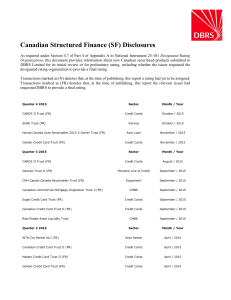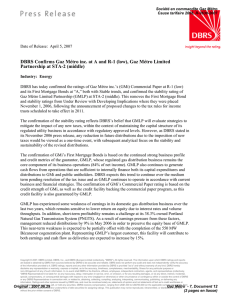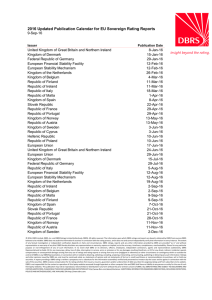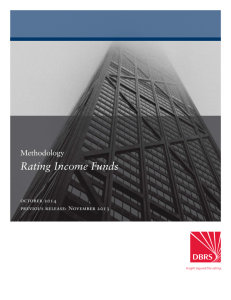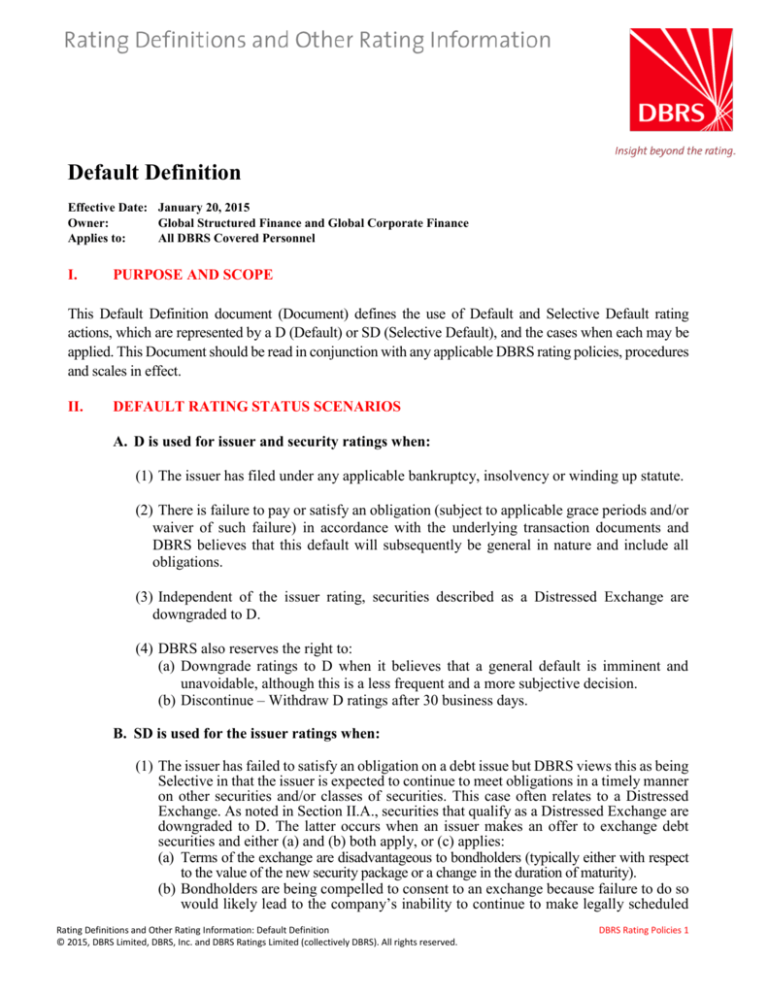
Default Definition
Effective Date: January 20, 2015
Owner:
Global Structured Finance and Global Corporate Finance
Applies to:
All DBRS Covered Personnel
I.
PURPOSE AND SCOPE
This Default Definition document (Document) defines the use of Default and Selective Default rating
actions, which are represented by a D (Default) or SD (Selective Default), and the cases when each may be
applied. This Document should be read in conjunction with any applicable DBRS rating policies, procedures
and scales in effect.
II.
DEFAULT RATING STATUS SCENARIOS
A. D is used for issuer and security ratings when:
(1) The issuer has filed under any applicable bankruptcy, insolvency or winding up statute.
(2) There is failure to pay or satisfy an obligation (subject to applicable grace periods and/or
waiver of such failure) in accordance with the underlying transaction documents and
DBRS believes that this default will subsequently be general in nature and include all
obligations.
(3) Independent of the issuer rating, securities described as a Distressed Exchange are
downgraded to D.
(4) DBRS also reserves the right to:
(a) Downgrade ratings to D when it believes that a general default is imminent and
unavoidable, although this is a less frequent and a more subjective decision.
(b) Discontinue – Withdraw D ratings after 30 business days.
B. SD is used for the issuer ratings when:
(1) The issuer has failed to satisfy an obligation on a debt issue but DBRS views this as being
Selective in that the issuer is expected to continue to meet obligations in a timely manner
on other securities and/or classes of securities. This case often relates to a Distressed
Exchange. As noted in Section II.A., securities that qualify as a Distressed Exchange are
downgraded to D. The latter occurs when an issuer makes an offer to exchange debt
securities and either (a) and (b) both apply, or (c) applies:
(a) Terms of the exchange are disadvantageous to bondholders (typically either with respect
to the value of the new security package or a change in the duration of maturity).
(b) Bondholders are being compelled to consent to an exchange because failure to do so
would likely lead to the company’s inability to continue to make legally scheduled
Rating Definitions and Other Rating Information: Default Definition
© 2015, DBRS Limited, DBRS, Inc. and DBRS Ratings Limited (collectively DBRS). All rights reserved.
DBRS Rating Policies 1
payments as agreed; as opposed to an offer that is purely opportunistic.
(c) A Distressed Exchange may also occur if the borrower repurchases a sizeable amount
of bonds at a major discount, and DBRS views this as a means of debt restructuring.
This would likely only apply to very low rated entities and the SD decision would
not apply if it was clear that the focus of the repurchases reflected considerations
more related to the opportunity to benefit from changing term or interest rates and
less related to the discount.
(2) Issuer ratings that are classified as SD may be reassessed in the future and a subsequent
rating action may be taken.
C. Structured Finance Transactions:
(1) For securitization transactions where assets are highly unlikely to repay future
obligations, DBRS generally downgrades the security to C until the legal maturity final
date of such obligation.
(2) For transactions where assets are structured and firewalled with a very high level of
certainty to be bankruptcy remote (for example, a first mortgage on a property that will
almost certainly result in an ongoing ability to keep payments current and fully repay
principal), the Rating Committee has the discretion to deviate from the principle that on
the occurrence of an insolvency event, all debt lines should be moved to D.
D. Recovery Ratings:
(1) Where an issuer rating is assigned Default status, any related recovery rating is
Discontinued – Withdrawn. For additional information on DBRS recovery ratings, see
DBRS Recovery Ratings for Non-Investment Grade Corporate Issuers under
Methodologies at www.dbrs.com.
E. Preferred Share Securities:
(1) With respect to preferred share securities, the non-payment of a dividend is only a Default
if the non-payment constitutes default per the legal documents. As such, the non-payment
of a dividend does not necessarily give rise to the assignment of a D rating.
Rating Definitions and Other Rating Information: Default Definition
© 2015, DBRS Limited, DBRS, Inc. and DBRS Ratings Limited (collectively DBRS). All rights reserved.
DBRS Rating Policies 2


